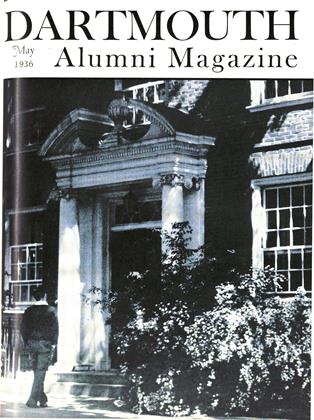By Edward Kilburn Robinson '04. Printed by Edward Martin Moore at the Pony Barn Press, Warrenville, Illinois. August, 1935.
In twelve pages Mr. Robinson has succinctly expressed his conception of what factors are necessary to produce the perfect book. This ideal book, he admits, has never been printed, as no great printer ever made a book which he thought could not be improved. This is true of any earthly and artistic ideal, and, as a matter of fact, book making, as the author implies, has reached in many instances high levels of distinction. Mr. Robinson aP" proaches his problem with humility as befits one who is dealing with something rare and beautiful. The ideal book will be approximated only by a designer who knows thoroughly types, papers, printing, the history of these, and who has within himself the qualities and understanding of a great artist. Mr. Robinson writes: "Whenever we meet a master in the making of books (such as Mr. Cobden-Sanderson of the former Doves Press), we shall discover that he is also a ceaseless student of his craft, always striving to reach the ideal." He will be an artist because "the beauty of a perfect page .... abounds with harmonies and rhythms, with symmetry and grace."
The author has long been connected with the publishing business (Ginn & Company) and gives technical details which are necessary in the production of the ideal book. For example: "Both type and paper should be chosen with the size of the book definitely 'in mind .... the ideal book will never contain a list of errata .... now I am disposed to think that the designer of a book need follow but few rules implicitly, if whatever he does is done so well as to make us feel that it could not be excelled in beauty or utility .... there will always be a wide latitude in the choice of dimensions for paper page, type page, and margins." These are eminently sensible statements and may serve to indicate the quality of the author's judgments. Mr. Robinson's essay deserves a better format than it has received in this thin book, which is printed in deep black Gothic type, not wisely spaced, and so hard on the eyes, and having, too, many irregular margins. It must be stated that the author had nothing whatever to do with the design or the printing of the book.
 View Full Issue
View Full Issue
More From This Issue
-
 Article
ArticleFRATERNITY REPORT SUBMITTED
May 1936 -
 Class Notes
Class NotesClass of 1902
May 1936 By Hermon W. Farwell -
 Article
ArticleGRADUS AD PARNASSUM
May 1936 -
 Class Notes
Class NotesClass of 1911
May 1936 By Prof. Nathaniel G. Burleigh -
 Class Notes
Class NotesClass of 1929
May 1936 By F. William Andres -
 Class Notes
Class NotesClass of 1930
May 1936 By Albert I. Dickerson
Herbert F. West
Books
-
 Books
BooksAmerica's Town Meeting of the Air.
April 1936 -
 Books
BooksAlumni Articles
MAY 1971 -
 Books
BooksShelf Life
Nov/Dec 2001 -
 Books
BooksTHE AUTOBIOGRAPHY OF JOHANNES BUTZBACH, A WANDERING SCHOLAR OF THE FIFTEENTH CENTURY.
June 1936 By Ashley K. Hardy '94 -
 Books
Books"THE PRESTIGE VALUE OF PUBLIC EMPLOYMENT,"
FEBRUARY 1930 By Charles Leonard Stone -
 Books
BooksHUMAN EMBRYOLOGY
October 1946 By W. W. Ballard '28






